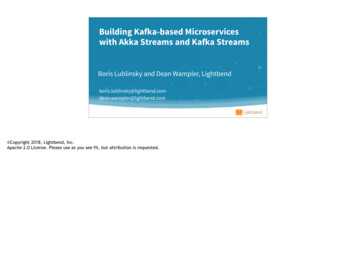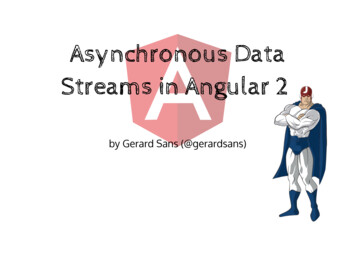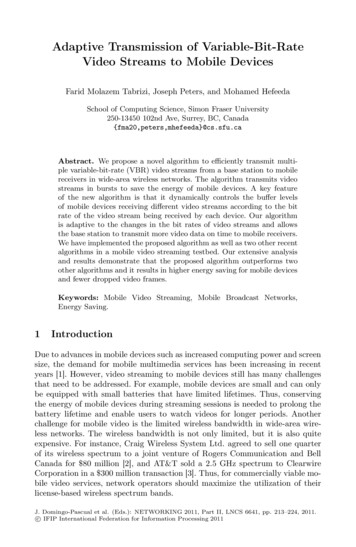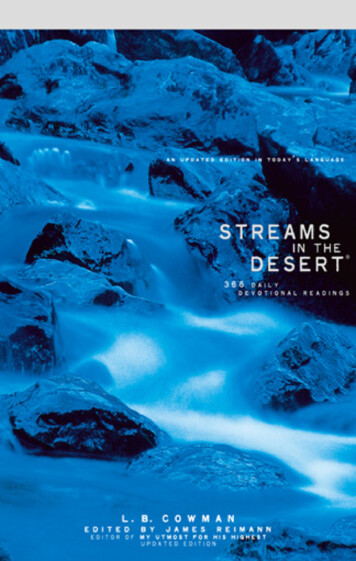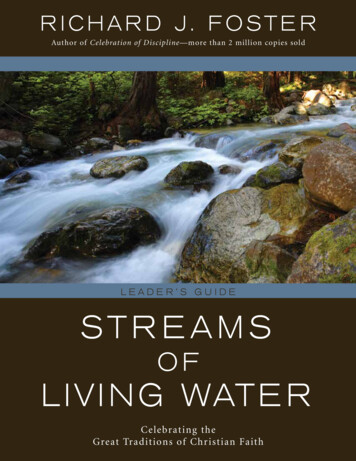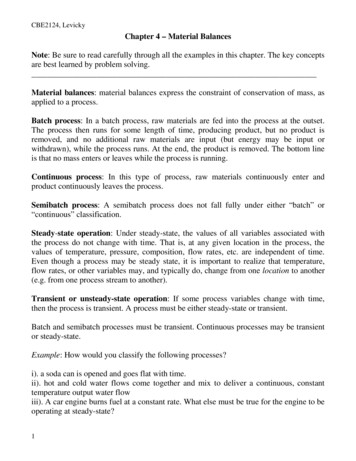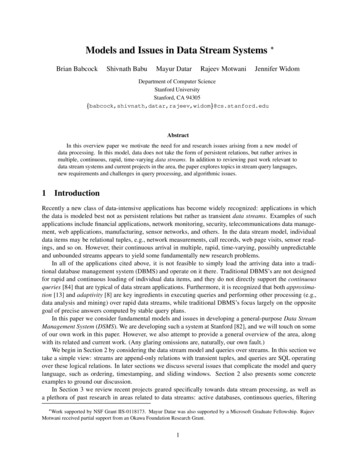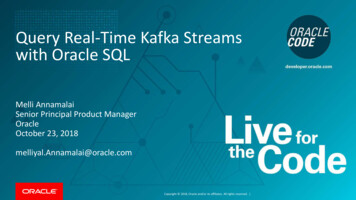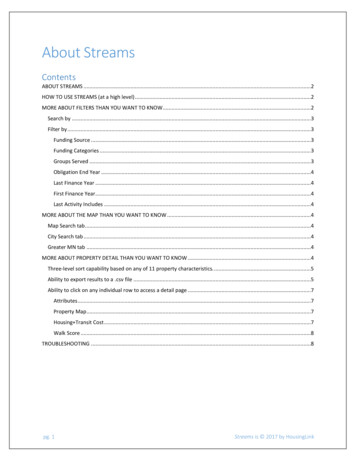
Transcription
About StreamsContentsABOUT STREAMS .2HOW TO USE STREAMS (at a high level) .2MORE ABOUT FILTERS THAN YOU WANT TO KNOW .2Search by .3Filter by .3Funding Source .3Funding Categories .3Groups Served .3Obligation End Year .4Last Finance Year .4First Finance Year .4Last Activity Includes .4MORE ABOUT THE MAP THAN YOU WANT TO KNOW .4Map Search tab .4City Search tab .4Greater MN tab .4MORE ABOUT PROPERTY DETAIL THAN YOU WANT TO KNOW .4Three-level sort capability based on any of 11 property characteristics. .5Ability to export results to a .csv file .5Ability to click on any individual row to access a detail page .7Attributes .7Property Map .7Housing Transit Cost .7Walk Score .8TROUBLESHOOTING .8pg. 1Streams is 2017 by HousingLink
ABOUT STREAMS What is Streams? Streams is a searchable database of publicly-funded (subsidized) rental housing inMinnesota. The intent is to maintain an unduplicated list of properties (and units), where a property willinclude all known associated addresses.How current is Streams? Streams currently includes all properties with a first finance closing through12/31/2015.What types of housing programs are covered in Streams? Streams aims to include any rental housingwith a long-term rent restriction (or direct rent subsidy) that makes it affordable for those earning 80% orless of the area median income (AMI). This includes Public Housing, Project-Based Section 8, LIHTC (taxcredit) properties, and many other programs funded at the state or local level. Streams does not includeemergency shelter or transitional housing.How comprehensive is Streams? Our goal is to have 100% coverage of Minnesota, but our data is only ascomplete as the input we get from local communities. We get data directly from Minnesota Housing,HUD, and the USDA, as well as directly from the cities of Minneapolis and St Paul (and put in a fair amountof elbow grease in reconciling them). We, then circle back with individual counties, communities, andnon-profit funders to see if we missed anything or got anything wrong. If you see something wrong ormissing in Streams, please let us know! We’re always looking for extra partners in ensuring ourcompleteness and accuracy.How does Streams define “property?: We have found that different funders of affordable housing defineand organize their investments in different ways, sometimes with multiple addresses within a single“property” record or with addresses that overlap those of another funder’s development. Our intent forStreams is to reconcile all of our source data into an unduplicated list of properties (and units), with thepotential for multiple addresses/buildings within any given property.HOW TO USE STREAMS (at a high level)Broadly, you can retrieve publicly-funded housing datasets by Panning and zooming a map to a specific geographic area.Searching by specific cities/counties.Searching by a street address or property name.Searching by unique identifier.Applying a number of additional filters relating to property characteristics.The map and a Property Search Summary will be updated automatically as each successive filter is added, and atany time you may click on an individual map pin in order to retrieve property results. However, when you aresatisfied with your search criteria, you may choose to “Show Results” which will display a property level tabularview of all properties matching your criteria along with key attributes. At this point you may: Export data to .csv file. This file will further expand property-level detail to individual rows by address (e.g.potentially more than one row per property.Click on any individual property row for an expanded view of all known attributes pertaining to it.MORE ABOUT FILTERS THAN YOU WANT TO KNOWNote that filters are additive within their “group” (the boldface headers), but limit results when used incombination with selections from other filter groups.pg. 2Streams is 2017 by HousingLink
Example 1: Selecting “Federal” and “State” within the “Funding Source” group will return all propertieswith either federal or state funding. Example 2: Selecting “Federal” and “State” within the “Funding Source” group and “Project-BasedSubsidy” from the “Funding Categories” group will return only properties with federal or state funding thatalso contain project-based subsidy (e.g. adding selections from a different group returns fewer results).Search by Property Name or Address: This will include partial matches (do not include the city if looking for anaddress; use the City Search or Greater MN tabs if you want to restrict your search to specific counties orcities).HUD, MN Housing, Public Housing, USDA/RD, or Tax Credit ID: With “X” representing variable stringcharacters and “0” representing numerals, please note the following typical formats:o HUD ID: “800000000”o MN Housing ID: “D0000”o Public Housing ID: “MN000000000”o USDA ID: “27-00-000000000-00-0” (the dashes are required)Filter byFunding Source Federal: This will return any properties for which we receive funding data from HUD or the USDA.State: This will return any properties for which we receive funding data from MN Housing.Philanthropic: This will return any properties for which we receive funding from the MN non-profitsFamily Housing Fund or Greater MN Housing Fund.Funding CategoriesOur source data reflects properties by way of funding mechanisms, or “programs,” that ensure affordability. Weassign each program a funding “category” and, just as a property may contain more than one funding mechanism,so may it reflect more than one category of funding. Categories are: Project-Based Subsidy: Returns any funding related to projects for which rent is federally subsidized.Public Housing: Returns properties for which we receive Public Housing project numbers from HUD.Tax Credit (LIHTC): Returns all properties for which we have any indication of tax credit funding (inclusiveof either/or/both 4% and 9%, below).Tax Credit (LIHTC 4%): Returns only properties for which we have indication of 4% tax credit funding.Tax Credit (LIHTC 9%): Returns only properties for which we have indication of 9% tax credit funding.Subsidized-Other: Returns all properties with funding that does not fit into another category.Groups ServedDetermination for groups served at the property level is derived through a combination of specific indication byour data sources and general program guidelines. These groups include: Family: Returns properties that are specifically targeted to families.Elderly: Returns properties that are specifically targeted to seniors.Disabled: Returns properties specifically targeted to households where the head-of-household has one ormore disabilities.pg. 3Streams is 2017 by HousingLink
Obligation End YearObligation refers to an obligation to offering below-market rents. Selecting a date range returns a property only ifits earliest obligation release date falls within the range.Last Finance YearSelecting a date range returns a property if its last finance close date falls within the range.First Finance YearSelecting a date range returns a property if its last finance close date falls within the range.Last Activity IncludesAt present, only MN Housing and Minneapolis’ Community Planning & Economic Development (CPED) providespecific, project-level indicators as to activity type. These activity types include: New Construction: Returns properties for which a “new construction” flag has been indicated. Other: Returns all properties for which a “new construction” flag has not been indicated.MORE ABOUT THE MAP THAN YOU WANT TO KNOWMap Search tabThis Google map is a dynamic filter, selecting for a dataset all properties that fall within its visible boundaries, andautomatically updating the “Property Search Summary” box under the map.Note that for ease of display: The map only displays a single address from any one property on the map, regardless of how manyaddresses the property actually has. For properties with more than one address, the “display address” issimply the address closest to the geographic center all addresses.The map will not display over 475 dots on the map. Results of the search will still be reflected in the“Property Search Summary” box, and be retrievable through the “Show Results” function.From the map view, you may choose to:Click “Show Results” to display all properties in tabular view beneath the map.Click on any one individual map pin (property) to return an expanded view of all known attributespertaining to it.City Search tab:This tab provides the opportunity to limit search results by county and/or city within the seven county Twin Citiesmetro.Greater MN tab:This tab provides the opportunity to limit search results by county and/or city within Greater MN.MORE ABOUT PROPERTY DETAIL THAN YOU WANT TO KNOW(Tabular data displayed after pressing “Show Results” button)Upon clicking “Show Results,” a tabular display of properties returned by the filter settings will appear below theGoogle Map window. Notable actions related to the table are:pg. 4Streams is 2017 by HousingLink
Three-level sort capability based on any of 11 property characteristics. Ref: An arbitrary number that references pins on the Google Map.Name: Data source consensus of property or development name.Address: Street address. Note: Properties may contain more than one address. The address returned hereis the address that lies closest the geographic center of all addresses within this property.City: City for property’s address.Address Count: Total number of addresses at property.Primary Funder***: Funding source of primary program ensuring affordability at the property in question.Property ID: Property number associated with funding source of primary program ensuring affordabilityat the property in question.Total Units: Total sum of both and unaffordable units.30% AMI: Total sum of units obligated to affordability for families earning at or below 30% of area medianincome.50% AMI: Total sum of units obligated to affordability for families earning between 30% and 50% areamedian income.60% AMI: Total sum of units obligated to affordability for families earning between 50% and 60% areamedian income.80% AMI: Total sum of units obligated to affordability for families earning at or above % of area medianincome.Afford. Units: Total sum of units obligated to affordability for families earning at or below 80% of areamedian income.Est: If total number of affordable units were not explicitly provided by our data sources and, instead,estimated based on program definitions.1st Close: Close date of first known financing mechanism that ensures affordability.Last Funding: Close date of last known financing mechanism that ensures affordability.Earliest Release**: First known date at which property loses its obligation to affordability.Est: Indicates whether data sources have provided specific guidance on obligation expiration) or whetherHousingLink has made assumptions about affordability levels based on program guidelines (estimated).Ability to export results to a .csv fileThe exported .csv file expands property records to include a row for each address within, and the followingcolumns: pg. 5HSDPropertyID: Housing Stock Data Property ID. A unique HousingLink property identifier.PropertyName: Data source consensus of property or development name.AddressCount: Total number of addressesReferenceAddress: Street address. Note: The first row of each property’s set of addresses is a “referenceaddress,” which is the address that lies closest the geographic center of all addresses within this property.ReferenceCity: City for property’s address.ReferenceState: State for property’s address (always MN!).ReferenceZipCode: Zip code for property’s address.ReferenceCounty: County for property’s address.ReferenceFunder: Funding source of primary program ensuring affordability at property in question.UnitsTotal: Total sum of both and unaffordable units.UnitsAffordable: Total sum of units obligated to affordability for families earning at or below 80% of areamedian income.Streams is 2017 by HousingLink
UnitsAMI30: Total sum of units obligated to affordability for families earning at or below 30% of areamedian income.UnitsAMI50: Total sum of units obligated to affordability for families earning between 30% and 50% areamedian income.UnitsAMI60: Total sum of units obligated to affordability for families earning between 50% and 60% areamedian income.UnitsAMI80: Total sum of units obligated to affordability for families earning at or above% of area medianincome.UnitsAMIEstimated: Indicates whether data sources have provided specific guidance on affordabilitylevels (not estimated) or whether HousingLink has made assumptions about affordability levels based onprogram guidelines (estimated).FirstFinancingClosedDate: Close date of first known financing mechanism that ensures affordability.LastFinancingClosedDate: Close date of last known financing mechanism that ensures affordability.FirstObligationReleaseDate: First known date at which property loses its obligation to affordability.ExpirationDateEstimated: Indicates whether data sources have provided specific guidance on obligationexpiration) or whether HousingLink has made assumptions about affordability levels based on programguidelines (estimated).YearBuilt: Year structure was built.UnitTypeID: Building type: SFH (single family home), CND (condo), TWN (townhome), DUP (duplex), orAPT (apartment), if known.Units0BR: Total 0 BR units.Units1BR: Total 1 BR units.Units2BR: Total 2 BR units.Units3BR: Total 3 BR units.Units4 BR: Total 4 BR units.NewConstruction: If “new construction” was flagged as an activity type from any data source (we arecurrently getting this data only from MN Housing and Minneapolis CPED).CreatedDate: The date on which the Streams record was created.LastUpdatedDate: The date, if any, on which the Streams record was updated.CityID: Any property ID associated with the property, if it had a city-level data source.CountyID: Any property ID associated with the property, if it had a county-level data source.CPEDID: Any property ID associated with the property, if it had Minneapolis’ CPED as a data source.Dak CntyID: Any property ID associated with the property, if it had Dakota County as a data source.FHFID: Any property ID associated with the property, if it had Family Housing Fund as a data source.GMHFID: Any property ID associated with the property, if it had Greater MN Housing Fund as a datasource.HUDID: Any property ID associated with the property, if it had HUD’s multifamily database as a datasource.HUDLIHTCID: Any tax credit ID associated with the property, if it had HUD’s LIHTC database as a datasource.HUDPHID: Any Public Housing Property ID associated with the property, if it had HUD’s Public Housingdatabase as a data source.MHFAID: Any MN Housing Project Number associated with the property, if it had MN Housing as a datasource.StPPEDID: Any property ID associated with the property, if it had St. Paul’s PED as a data source.TCID: Tax credit ID, if any.TC4ID: Tax credit ID, if property carries 4% tax credits.pg. 6Streams is 2017 by HousingLink
TC9ID: Tax credit ID, if property carries 9% tax credits.USDAID: Any USDA Project Number associated with the property, if it had the USDA as a data source.Wash CntyID: Any property ID associated with the property, if it had Washington County as a datasource.Ability to click on any individual row to access a detail pageProperty detail pages provide an expansive set of attributes specific to the property selected from the tabularview, above, as well as some additional features.Attributesi Property Name (appearing in blue).Property Address. In the event there is more than one address for the property, only theReferenceAddress (see above) is listed at the top, with other known property addresses listed below.Funding Categories: Categories of funding present in the property.Property Informationo Year Builto Building Typeo Groups Servedo Total Unitso Affordable UnitsAffordable Units by BedroomUnits by Area Median IncomeFunding Dates and Programso First known closingo Most recent closingo Earliest expirationo Last ActivityKnown Property Identifiers (by data source and respective ID)Listing Summary: A reference to any instances in which this Streams property has appeared inHousingLink’s rental search tool as a vacancy or waiting list opening, with the following propertycharacteristics:o BR Size: Number of bedrooms for which a listing appeared.o 1st Listing: The first time this property appeared.o Last Listing: The last time this property appeared.o Low Rent: Lowest observed rent amount.o High Rent: Highest observed rent amount.o Last Rent: Last observed rent amount.Known Property AddressesProperty MapA Google Map displaying all addresses associated with the property in question.Housing Transit CostClicking on this hyperlink will send the property address to the MSP Housing Transportation Cost Calculator,sponsored by the Regional Council of Mayors, Urban Land Institude, and Center for Neighborhood Technology.This tool allows users to see how a number of user-defined parameters, in addition to property address, helpdetermine total costs associated with a housing choice.pg. 7Streams is 2017 by HousingLink
Walk ScoreIn addition to providing the WalkScore metric, clicking this hyperlink sends the address to the WalkScore website,where a user may view a number of neighborhood characteristics, ranging from an overall assessment of“walkability” to nearby retail and services.TROUBLESHOOTINGThe .csv export isn’t working? You may need to create an exception in your browser to allow for pop-ups.iIf not given in the list below, property attributes are defined elsewhere in this document.pg. 8Streams is 2017 by HousingLink
Streams currently includes all properties with a first finance closing through 12/31/2015. What types of housing programs are covered in Streams? Streams aims to include any rental housing with a long-term rent restriction (or direct rent subsidy) that makes it affordable for those earning 80%
